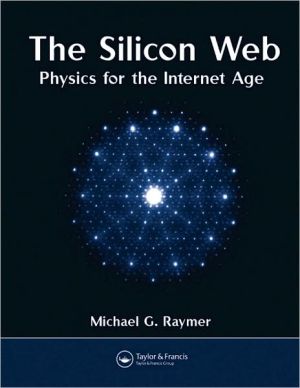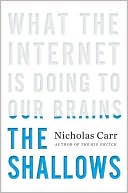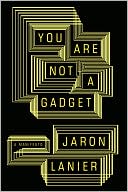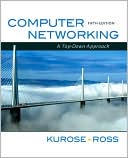The Silicon Web: Physics for the Internet Age
The technology behind computers, fiber optics, and networks did not originate in the minds of engineers attempting to build an Internet. The Internet is a culmination of intellectual work by thousands of minds spanning hundreds of years. We have built concept upon concept and technology upon technology to arrive at where we are today, in a world constructed of silicon pathways and controlled by silicon processors.\ From computers to optical communications, The Silicon Web: Physics for the...
Search in google:
The technology behind computers, fiber optics, and networks did not originate in the minds of engineers attempting to build an Internet. The Internet is a culmination of intellectual work by thousands of minds spanning hundreds of years. We have built concept upon concept and technology upon technology to arrive at where we are today, in a world constructed of silicon pathways and controlled by silicon processors.From computers to optical communications, The Silicon Web: Physics for the Internet Age explores the core principles of physics that underlie those technologies that continue to revolutionize our everyday lives. Designed for the nonscientist, this text requires no higher math or prior experience with physics. It starts with an introduction to physics, silicon, and the Internet and then details the basic physics principles at the core of the information technology revolution. A third part examines the quantum era, with in-depth discussion of digital memory and computers. The final part moves onto the Internet era, covering lasers, optical fibers, light amplification, and fiber-optic and wireless communication technologies.The relation between technology and daily life is so intertwined that it is impossible to fully understand modern human experience without having at least a basic understanding of the concepts and history behind modern technology, which continues to become more prevalent as well as more ubiquitous. Going beyond the technical, the book also looks at ways in which science has changed the course of history. It clarifies common misconceptions while offering insight on the social impacts of science with an emphasis on information technology.As a pioneering researcher in quantum mechanics of light, author Michael Raymer has made his own significant contributions to contemporary communications technology
Introduction: Physics and Its Relation to Computer and Internet Technologies Physics, Silicon, and the “Magic” behind the Internet Age A Zoomed-In Look inside a Computer Timeline of Great Discoveries and Inventions in Physics and Computer and Communication Technologies The Methods and Significance of Science The Relation of Science and Information Technology Social Impacts: Science and Technology Mathematics: The Language of Science and Technology The Utility of Mathematics in Science and Technology Graphs Precision and Significant Digits Large and Small Numbers and Scientific Notation Real-World Example 2.1: Precision of Display Pixels Units for Physical Quantities Proportionality Binary Numbers The Concept of Information Exponential Growth Social Impacts: The Exponential Change of Nearly EverythingMechanics: Energy Enables Information TechnologyFrom Looms to Computers Speed, Acceleration, and Force In-Depth Look 3.1: Distance Traveled under Constant Acceleration Real-World Example 3.1: Seek Time of a Hard-Drive Head In-Depth Look 3.2: Net Force Vectors Real-World Example 3.2: Acceleration in Cathode-Ray TubesPrinciples of Mechanics Real-World Example 3.3: Force on a Hard-Drive Head The Physics of Energy Friction and Thermal Energy The Constancy of Energy Units for Mechanics Power Real-World Example 3.4: Motion Sensors in Laptops Social Impacts: Scientific Thought and Methods Have Arguably Changed the Course of Human History More Than Anything ElseMatter and Heat: Cooling Computers is Required by the Physics of ComputationFrom Steam Engines to Computers Matter and Atoms Gases, Liquids, and SolidsIn-Depth Look 4.1: Size and Numbers of Atoms Real-World Example 4.1: Growing Silicon Crystals for Computer ChipsPressure in a Gas Pressure in a Liquid Pumps, Current, and ResistanceReal-World Example 4.2: A Water-Pressure-Operated ComputerTemperature The Ideal Gas Heat and Thermal Energy TransferReal-World Example 4.3: Cooling Computer Chips Principles of Thermodynamics: Extracting Work from Heat Cooling Computers is Required by the Physics of Computation Social Impacts: The Industrial Revolution and the Information Revolution Electricity and Magnetism: The Workhorses of Information TechnologyElectricity and Magnetism Are the Basis of Computers and the Internet Electric ChargeIn-Depth Look 5.1: The Concept of Plus and Minus Electric ChargeElectric Forces: Coulomb’s LawIn-Depth Look 5.2: The Discovery of the ElectronElectric FieldsIn-Depth Look 5.3: Electric Field LinesElectric Current and Conductors Electrical Energy and VoltageReal-World Example 5.1: Capacitor Computer MemoryResistors, Conductors, and Ohm’s Law Electrical Power Magnetism Electromagnetism Real-World Example 5.2: The Telegraph, Precursor to the Internet In-Depth Look 5.4: Magnetic Materials and Data Storage Social Impacts: Innovation and Public Support of ScienceDigital Electronics and Computer LogicThe “Reasoning” Abilities of Computers Concepts of Logic Electronic Logic Circuits Logic Operations and Diagrams Using Logic to Perform Arithmetic Implementing Logic with Electromagnetic SwitchesSupplemental Section: Boolean Search of Databases Chapter 7 Waves: Sound, Radio, and Light Communicating with Sound, Radio, and Light Simple Harmonic Motion Damped and Complex Harmonic Motion Driven Harmonic Motion and Resonance In-Depth Look 7.1: Resonance Frequencies Real-World Example 7.1: Crystal Oscillators and Microprocessor Clocks Waves Simple Harmonic Waves Interference of WavesIn-Depth Look 7.2: Standing WavesSound WavesIn-Depth Look 7.3: BeatsWireless Radio WavesReal-World Example 7.2: AM RadioLet There Be Light WavesIn-Depth Look 7.4: Light Polarization Real-World Example 7.3: LCD ScreensInterference of Light Social Impacts: Music, Science and Technology Analog and Digital CommunicationCommunication Systems: Analog and Digital Basics of Analog Radio Basics of Digital Radio The Maximum Rate of Transmitting Data Maximum Data Rate Frequency Multiplexing and BandwidthIn-Depth Look 8.1: Signal ReconstructionQuantum Physics of Atoms and MaterialsAtoms, Crystals, and Computers The Quantum Nature of Electrons and Atoms The Experiments behind Quantum TheoryIn-Depth Look 9.1: Spectrum of Hydrogen AtomsThe Spinning of Electrons The Principles of Quantum Physics Building Up the AtomsReal-World Example 9.1: Fluorescent LampsElectrical Properties of MaterialsIn-Depth Look 9.2: Origin of the Energy Gap in Silicon Crystals In-Depth Look 9.3: Atomic Nature of Magnetic Domains Social Impacts: Science, Mysticism, and Pseudo-Science Semiconductor Physics: Transistors and CircuitsSilicon, Transistors, and Computers Controlling the Conductivity of Silicon p-n Junctions and Diodes Real-World Example 10.1: A Simple Crystal AM Radio ReceiverTransistors CMOS Computer Logic In-Depth Look 10.1: Water-Effect Transistors Miniaturization, Integrated Circuits, and Photolithography In-Depth Look 10.2: Bipolar Transistors Social Impacts: Labeling Every Object in the World Digital Memory and Computers Physics, Memory, and Computers Sequential Logic for Computer Memory Feedback Example #1: NOT Loop Feedback Example #2: One-Time Latch Static Random-Access Memory In-Depth Look 11.1: SRAM with Six Transistors Dynamic Random-Access Memory Nonvolatile Memory In-Depth Look 11.2: Quantum Tunneling Magnetic Tape and Hard Disk Memory Optical Compact Disk Memory Error Immunity of Digital Data The Structure of a Computer Hierarchy of Computer Memory Heat-Imposed Limits of Computers Representing Information in Computers using Codes Coding Images Data Compression Photons: Light Detectors and Light Emitting DiodesLight, Physics, and Technology The Quantum Nature of Light—Photons Power and Energy in Light Absorption of Light by Atoms and Crystals (or “How Einstein Got His Nobel Prize”)In-Depth Look 12.1: Inability of Constant Voltage to Accelerate Electrons in an Insulator Real-World Example 12.1: Semiconductor Light DetectorsEmission of Light by Atoms and CrystalsReal-World Example 12.2: Light-Emitting Diodes Social Impacts: Lighting the Darkness (Efficiently)Light and Optical Fibers for the InternetLight as a Communication Medium Propagation, Reflection and Transmission of Light Light in Transparent Media Refraction of Light at a Boundary Reflection of Light at a Boundary Total Internal Reflection Prisms and Speeds of Different Colored Light Lenses and Curved Mirrors Optical Loss in Materials—The Clarity of Optical Fiber Light Guiding Optical Fibers Light Pulses in Optical FibersSocial Impacts: Total Immersion in a Sea of InformationLight Amplification and LasersAtoms and Lasers The Uniqueness of Laser Light Absorption and Emission of Light by Atoms Laser ResonatorsIn-Depth Look 14.1: Laser Resonator FrequenciesHow a Laser Works The Helium-Neon LaserIn-Depth Look 14.2: Extreme Laser FactsVariable-Color Semiconductor Lasers Overcoming Losses in Fiber-Optic Systems Quantum Physics Description of Lasers The Semiconductor Diode LaserFiber-Optics CommunicationBandwidth and the Physics of Waves Overview of Fiber-Optical Communication Systems Modulating a Laser Beam with Data Wavelength Multiplexing in Optical Communication The Virtues of Lasers for Optical Communication Hardware for Wavelength Multiplexing Laser Beam RoutingCommunication Networks and the InternetThe Physics behind the Internet The Goals of Computer Communication Networks Noise in Analog and Digital Systems Challenges in Networking Broadcasting Networks and Switching Networks Failure-Resistant Communications Wireless Mobile Cell Phone Networks Propagation of Wireless Waves in TerrainSummary of Scientific Notation and Units Sources and Credits for Quotes Used with Permission Glossary








